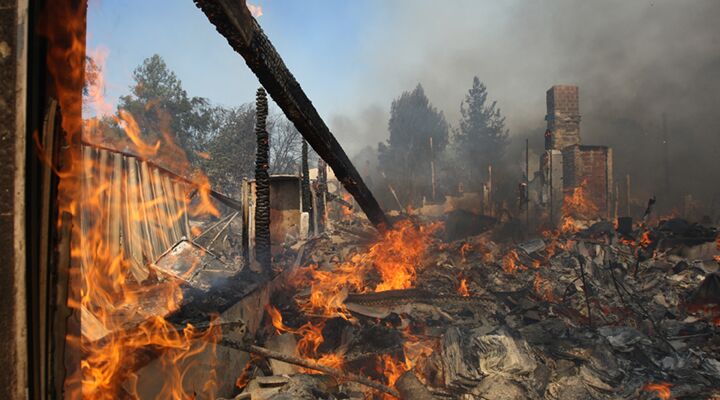
Wild Fires and ‘Firenadoes’ Rage in Southern California
Streaks of bright orange flames against a backdrop of thick black smoke envelope parts of Southern California as a result of 11 wildfires that began on May 13. Gov. Jerry Brown declared a state of emergency in San Diego the following day.
The inferno has destroyed more than 27,000 acres of land in the San Diego area. “[I]t was like a bomb went off,” said one resident of the charred remains of her home. The fire has damaged two businesses, at least 22 homes and one 18-unit condominium complex. So far, one fire-related death has been reported in the city of Carlsbad.
Intense heat from the fires sucked in cooler air, resulting in the circulation of tornado-like funnels of flames dubbed “firenadoes.”
About 125,000 evacuation notices have been sent to residential areas, schools and businesses. In the city of Escondido alone, more than 15,000 people have been evacuated, including those at the 12-story Palomar Medical Center West. Fire department crews have been stationed at the hospital to protect it should the furious flames lurch too close.
https://www.youtube.com/watch?v=x95Sh-rWhW4&feature=youtu.be
Strong winds create “firenadoes” as fires continue to rage outside of San Diego on May 16.
Wildfires in California have transformed firefighting to become more proactive than reactive. Typically seasonal firemen are going on the offensive and are working year-round to contain and prevent fires. Every season has been fire season, according to Thomas Porter of the California Department of Forestry and Fire Protection (cal fire). This year alone, cal fire logged over 1,400 wildfires—double what is normally expected. California anticipates spending $240 million on firefighting this year.
In this latest scourge, 2,000 firefighters and tens of military water-dropping helicopters were deployed to pour thousands of gallons of water and flame retardants on the fire. The measures appeared to do as much good as raindrops on an ocean of fire.
The fire began May 13 in San Diego County. On the next day, eight other disparate fires developed, raising suspicion of arson. One adult and two teenagers have been arrested along those suspicions. But observers said the wildfires could have been started by means as innocuous as sparks from vehicles. The fact that the nearly simultaneous fires are so spread out could be a result of embers being blown as far as a mile away by wind gusts of up to 45 miles per hour in the summer heat of about 100 degrees Fahrenheit.
California’s current drought—the worst in centuries—has not helped matters. According U.S. Drought Monitor data released May 15, the entirety of California is experiencing “severe” drought conditions or worse—the first time in 14 years. This aridity has created acres of dry, highly combustible vegetation. “Unfortunately,” cal fire Capt. Mike Mohler told cnn, “Mother Nature was not on our side today.”
One mother who was forced to evacuate her home with only one shoe and her son remarked, “I’ve lost enough stuff in my life …. It’s just stressful. You realize what’s really important really quick.”
In “Something Is Wrong With the Weather,” we discuss some of those “really important” aspects of life that volatile weather patterns can teach us. “Such catastrophes should in fact challenge our thinking,” we wrote. “They force us to contemplate the fragility of man. They demand that we consider some of the deeper questions we can all-too-easily ignore in more prosperous and peaceful times.” Read what we’ve written about this subject, and consider the deep questions prompted by our frightful weather.
